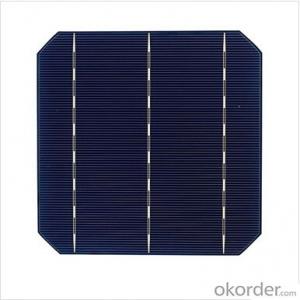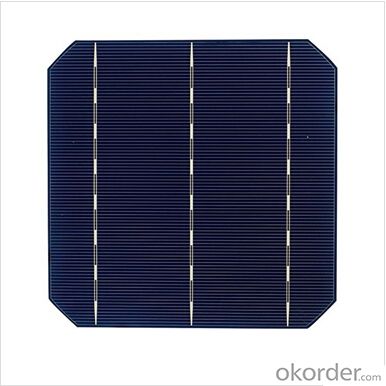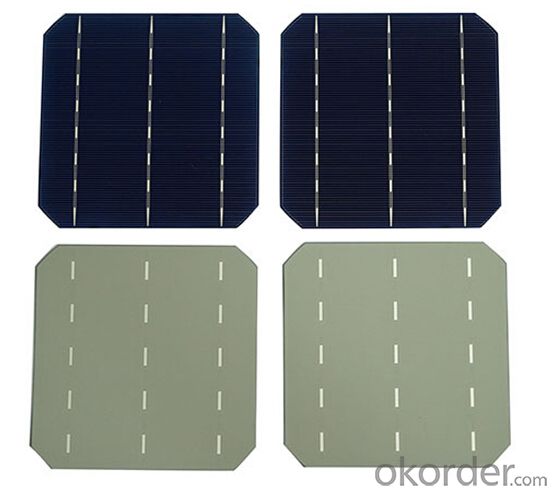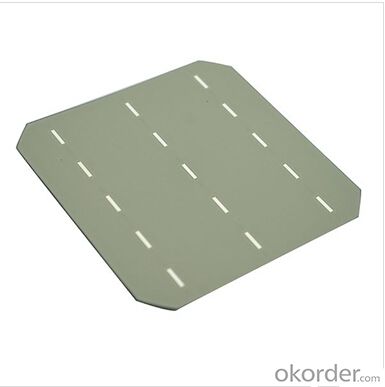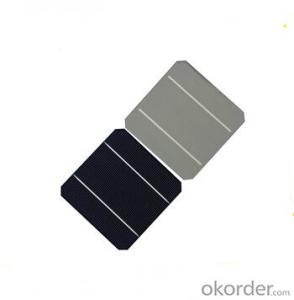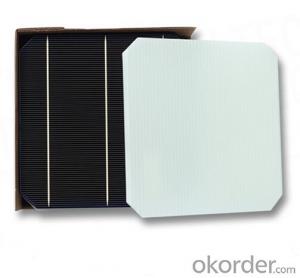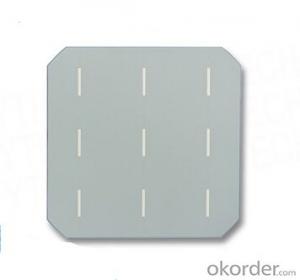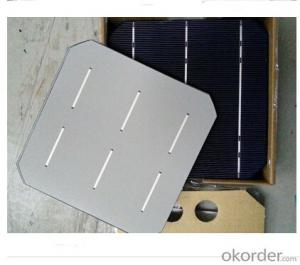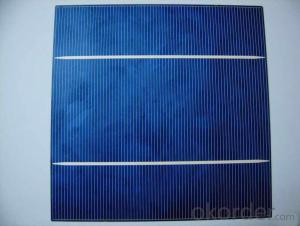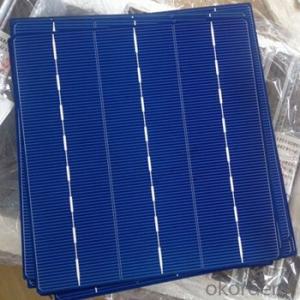A Grade 17.4% Monocrystalline Solar Cells and Modules
- Loading Port:
- Shanghai
- Payment Terms:
- TT OR LC
- Min Order Qty:
- 5000 pc
- Supply Capability:
- 800000 pc/month
OKorder Service Pledge
OKorder Financial Service
You Might Also Like
Monocrystalline Solar Cells A GRADE
A solar cell, is an electrical device that converts the energy of light directly into electricity by the photovoltaic effect, which is a physical and chemical phenomenon. It is a form of photoelectric cell, defined as a device whose electrical characteristics, such as current, voltage, or resistance, vary when exposed to light. Solar cells are the building blocks of photovoltaic modules, otherwise known as solar panels.
Advantage of Monocrystalline Solar Cells
• High efficiency and stable performance in photovoltaic conversion.
• Advanced diffusion technique ensuring the homogeneity of energy conversion efficiency of the cell.
• Advanced PECVD film forming, providing a dark blue silicon nitride anti-reflection film of homogenous color and attractive appearance.
• High quality metal paste for back surface and electrode, ensuring good conductivity, high pulling strength and ease of soldering.
• High precision patterning using screen printing, ensuring accurate busbar location for ease with automatic soldering a laser cutting.
Specifications of Monocrystalline Solar Cells
Efficiency (%) Pmpp (W) Umpp (V) Impp (A) Uoc (V) Isc (A) |
18.20% 4.43 0.536 8.263 0.634 8.712 |
18.00% 4.38 0.535 - 8.188 0.633 8.701 |
17.80% - 4.33 0.534 - -8.112 ---0.632 ----8.652 |
17.60% 4.28 0.533 8.036 0.631 8.641 |
17.40% 4.23 0.529 8.005 0.630 8.591 |
Applications of Monocrystalline Solar Cells
Assemblies of photovoltaic cells are used to make solar modules which generate electrical power from sunlight, as distinguished from a "solar module" or "solar panel". A solar array generates solar power using solar energy.
Packaging & Delivery of Monocrystalline Solar Cells
Carton Box Package and Deliver by air. It should be noticed that it should be avoid of water, sunshine and moist.
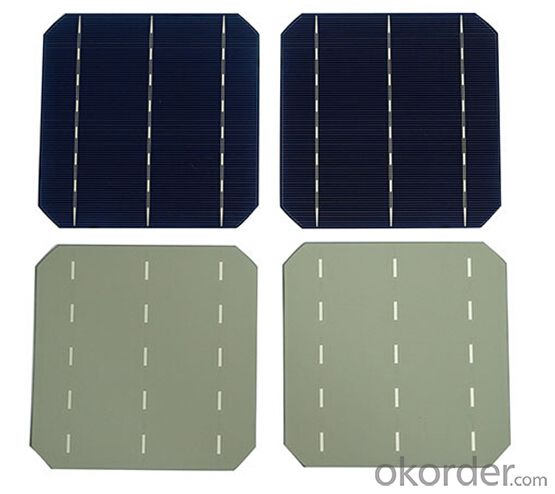
FAQ
We have organized several common questions for our clients,may help you sincerely:
①What price for each watt?
It depends on the efficiency of the solar cell, quantity, delivery date and payment terms.
②How long can we receive the product after purchase?
In the purchase of product within three working days, We will arrange the factory delivery as soon as possible. The pecific time of receiving is related to the state and position of customers.Commonly 7 to 10 working days can be served.
③Can you provide the peripheral products of the solar panels, such as the battery, controller, and inverter? If so, can you tell me how do they match each other?
Yes, we can, we have two companies for solar region, one is CNBM International, the other is CNBM engineering Co.
We can provide you not only the solar module but also the off grid solar system, we can also provide you service with on grid plant.
④What is your warranty of solar cell?
Our product can promise lower than 0.3% open box crack, we support claim after opening the box if it has crackm color difference or sth, the buyer should give pictures immediately, we can not accept the claim after the solar cell has assembled to solar panel.
• Timeliness of delivery
• ⑤How do you pack your products?
We have rich experience on how to pack the solar cell to make sure the safety on shipment, we could use wooden box or pallet as buyer's preference.
⑥ Can you do OEM for us?
Yes, we can.
- Q: How do solar cells impact greenhouse gas emissions?
- Solar cells have a positive impact on greenhouse gas emissions as they generate electricity from renewable and clean energy sources, such as sunlight. By utilizing solar cells to generate power, we reduce the reliance on fossil fuels, which are major contributors to greenhouse gas emissions. Therefore, solar cells help to mitigate climate change by reducing the overall carbon footprint and promoting a more sustainable and eco-friendly energy system.
- Q: Can solar cells be used in emergency lighting?
- Yes, solar cells can be used in emergency lighting. Solar-powered emergency lights are designed to provide illumination during power outages or emergencies by utilizing solar panels to convert sunlight into electricity, which is then stored in batteries for later use. This makes them a reliable and sustainable option for emergency lighting solutions.
- Q: What is the role of power optimizers in solar cell systems?
- Power optimizers play a crucial role in solar cell systems by maximizing the energy output of each individual solar panel. They work by individually monitoring and optimizing the performance of each panel, thereby minimizing power losses caused by shading, mismatch, and other factors. This optimization helps to improve the overall efficiency and reliability of the solar system, ensuring that it operates at its highest potential and delivers maximum energy yields.
- Q: What is the future of solar cell technology?
- The future of solar cell technology looks promising as advancements continue to be made in efficiency, flexibility, and affordability. With ongoing research and development, we can expect to see solar cells becoming more efficient in converting sunlight into electricity. Additionally, innovative designs such as transparent solar cells and solar-powered windows are being explored, expanding the possibilities for integration into everyday objects and infrastructure. As costs continue to decrease, solar energy will likely become more accessible and widespread, contributing to a cleaner and more sustainable future.
- Q: Can solar cells be used in camping or outdoor recreational activities?
- Yes, solar cells can be used in camping or outdoor recreational activities. They are a convenient and environmentally friendly way to generate electricity in remote locations where power outlets may not be available. Solar panels can be used to charge portable devices such as phones, laptops, or camping lights, providing a sustainable source of energy while enjoying outdoor activities.
- Q: What are the 3 things you need to know before you start to make solar cells?
- I remembered I made solar cells with my dad when I was 10 years old, and all I can remember now are the difficulties in getting the silicon working properly.
- Q: How do solar cells handle dust storms or sandstorms?
- Solar cells are designed to withstand dust storms or sandstorms by incorporating protective measures. The surface of solar panels is typically made of tempered glass or other durable materials that can resist scratches or damage caused by blowing dust or sand. Additionally, the panels are often tilted or installed at an angle, allowing the wind to blow away any accumulated dust. Regular cleaning and maintenance are also carried out to ensure optimal performance in dusty conditions.
- Q: Can solar cells be used for powering wildlife tracking devices?
- Yes, solar cells can be used for powering wildlife tracking devices. Solar cells convert sunlight into electrical energy, which can be stored in batteries and used to power various devices, including wildlife tracking devices. This allows for continuous and sustainable power supply, eliminating the need for frequent battery replacements or recharging.
- Q: Are solar cells environmentally friendly?
- Yes, solar cells are environmentally friendly. They produce clean and renewable energy by harnessing sunlight, which reduces dependence on fossil fuels and lowers greenhouse gas emissions. Additionally, solar cells do not produce any air or water pollution during operation, making them a sustainable and eco-friendly energy source.
- Q: What factors affect the output of a solar cell?
- Several factors can affect the output of a solar cell. The most significant factors include the intensity and angle of sunlight, the temperature of the cell, the efficiency of the cell's materials (such as the type of semiconductor used), and any shading or obstructions that may limit the exposure of the cell to sunlight. Additionally, the condition and cleanliness of the cell's surface, as well as the overall design and quality of the solar cell system, can also impact its output.
Send your message to us
A Grade 17.4% Monocrystalline Solar Cells and Modules
- Loading Port:
- Shanghai
- Payment Terms:
- TT OR LC
- Min Order Qty:
- 5000 pc
- Supply Capability:
- 800000 pc/month
OKorder Service Pledge
OKorder Financial Service
Similar products
Hot products
Hot Searches
Related keywords
